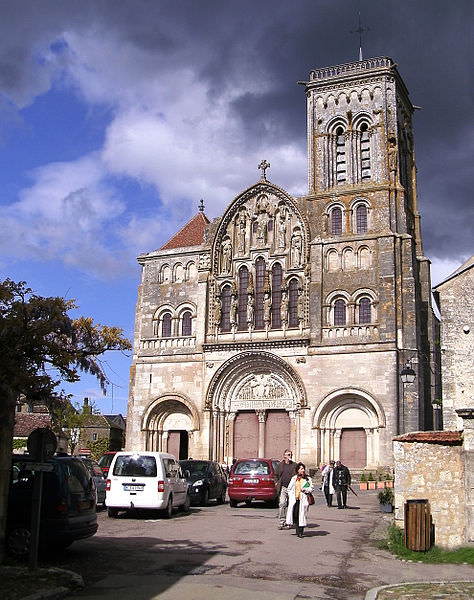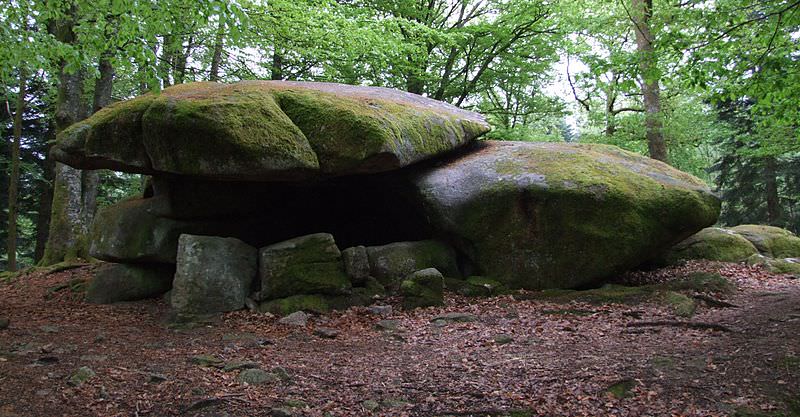For eight centuries, pilgrims have come to the great basilica in Vezelay to be blessed on their long journey to Santiago de Compostela in Spain, a pilgrimage that was, and is today, a significant spiritual journey. The Basilica Saint Mary Magdalene still awes visitors like John and me. A masterpiece of Romanesque architecture of the Middle Ages, it was famous in the 12th century for its relics of Mary Magdalene, which drew crowds of worshipers (and conveniently boosted the regional economy, as they all had to be housed and fed.)

A scenic view of the Basilique Ste-Madeleine and the town of Vezelay stretching along the hill below it. Photo © Holly Hayes
Unfortunately for local merchants, other relics of the saint were found in Provence, and Vezelay’s popularity declined. Religious wars and the French revolution battered the church, but it was saved from ruin in the 19th century by the architect Viollet-le-Duc, and restored to the impressive state you see today.
In the silent, underground crypt, beneath a low vaulted ceiling, we gazed upon an elaborate gold-and-glass reliquary containing what appeared to be a small, age-browned bone — the last of Vezelay’s Mary Magdalene relics.
”Is it really hers?”‘ I asked a Frenchwoman.
She shrugged.”Perhaps. Or maybe,” she added with a wicked laugh, “‘a chicken bone?”
Whatever your beliefs, the basilica and the medieval village (pop. 492), which extends along a ridge above green fields, are well worth a visit. The tourist office on the main street has a map of walking tours and advice on what to see and where to shop, eat and stay. John and I were happy with our hotel, La Poste et Lion dÓr, set at the bottom of the cobbled street leading up to the church. Most of its 37 rooms are under 100 euros per night for 2 people. Ours was spacious and comfortable, with casement windows overlooking the old stone houses, and a big bathtub, very welcome after hours of traipsing hard streets, often in the rain (unusual weather for springtime here, we were told.)
The hotel staff was friendly and helpful, the restaurant excellent. My trout almandine was perfectly cooked and delicious. A good restaurant choice for more casual meals is Dents Creuse, offering pizzas, chicken, salads and more. We opted to skip that spot and visit the lovely church instead and admire its Gothic arches.
In our little Ford Fiesta we continued on to Semur-en-Auxois, a pretty town 45 minutes from Vezelay. Following the walking tour map we picked up at the tourist information office, we strolled the peaceful medieval streets, crossed the bridges over the Armancon River, and ducked out of the rain into the beautiful church. Dating from the 13th century, its vaulted ceiling is 65 feet high. Always on the lookout for places off the beaten path, we were pleased to find a small bar and cafe in Semur, the St. Vernier, where we ate well, drank good local wine, and met the friendly regulars.
Bidding au revoir to the guys at the bar, we headed into the countryside to Fontenay Abbey. The large complex of buildings, bordering a forest of beech and ash trees, began in the 1100s. Restored, the abbey is a U.N. World Heritage Site providing a glimpse of life in a medieval monastery. The Cistercian monks had gardens, a bakery, cloisters, a church, and even mined iron ore.
For something different, even further off the usual tourist route, we drove into the Morvan, south of Vezelay. This large regional park, in the granite heart of Burgundy, has lakes, streams, wildlife, villages, and miles of trails winding through forests. We’d planned to hike, bicycle and maybe even kayak, but not in the rain, so we hit some highlights. We tracked down an immense dolmen (a prehistoric tomb), Dolmen de Chevresse, in mossy green woods outside St. Brisson. You can’t get much further off the trodden paths than this. The multi-ton stones stand isolated among the oaks and alders, as they have for thousands of years. How was the dolmen made? No one really knows.
We picnicked by a lake where cranes soared over still water and frogs croaked in the rushes; found the ancient, moss-covered sarcophagi of Merovingian kings; and best of all spotted a great chocolate shop on the church square in the village of Quarre’ les Tombes.
We didn’t find chocolate in Flavigny-sur-Ozerain, the quaint old village where the movie “Chocolat”was filmed. However, it’s known for its anise-flavored candy, as well as a museum of textiles, wine, and a fine restaurant, Le Relais de Flavigny. They’ve all been recommended, but I can speak only of the candy, which is nice but, well, what can I say, it’s not chocolate.
More Information: The Yonne
Written by Marilyn McFarlane for EuropeUpClose.com


